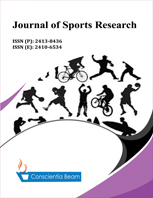Effectivenes of Hipermobility on Sport Injury among Young Players
DOI:
https://doi.org/10.18488/journal.90.2020.71.44.49Abstract
The aim of this study is to investigate the relationship between hypermobility and sport injury in different sports branches. A total of 256 athletes who were 15,7±7,6 years average age from 5 different branches (football: 52 basketball: 28 volleyball: 32 swimming: 28 and athletics: 19) participated in the study voluntarily. Beighton hypermobility diagnostic scoring and sport injury history questionnaire were used to data collection. Study showed that; 19.5% of the participants were found to be advanced hypermobile. The highest rate of hypermobile was found in Volleyball branch (n: 12/37.5%). The incidence of hypermobility syndrome in women was found to be higher than in men (42.3%). 58.9% of the athletes had previously had a injury, the type of sprain injury was the most common type of injury (37.7%), the foot and ankle was the most injured body part (48.1%). Injury mostly occurs in training (45.3%). Overuse was the most injury reason (35.2%). Duration of the recovery was 1-3 weeks mostly answered (30.9%). Injury mostly seen in football branches (60.9%). No relationship was found between the injury status of the athletes and hypermobility levels (p= 0.103). As a result of the research; hypermobility prevalence was 19.5% found among participants. According to gender, analysis showed that; It was seen more frequently in women and the rate of hypermobility in volleyball branch was higher than other branches. On the other hand, it was found that the level of hypermobility had no effect on the sport injury history of the young athletes.

